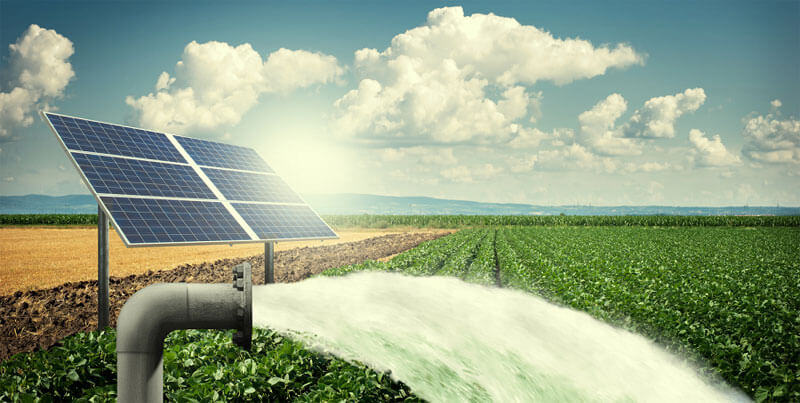
[cspt-portfolio h_h2=”Solar Water Pump” h_h4=”Solar Water Pumping System Solution” h_description=”Solar systems are used all over the world for the production of cheap electricity. The use of the solar system is increasing day by day. This is because the solar electricity cost is low than other sources of electricity.
The solar system is used to drive different systems such as solar water pump, turbines and many other units. This article mainly focuses on the solar system and solar water pump.
Solar water pump is driven by the electricity produced by the PV (photovoltaic) panels or the radiant heat generated by collected sunlight. This is the opposite of a diesel or grid electricity water pump.
The solar powered pump uses solar energy for operation. It consists of a water storage tank, electrical cables, a breaker/fuse box, a DC water pump, a solar charge controller (MPPT), and a solar panel array.
Solar pumps have a lower environmental impact compared to pumps powered by IC engines or utility electricity. The pump with a solar system is a delightful technology with which remote areas can be supplied with water both ecologically and socially. Therefore, it is always the economic technology of choice.
Millions of people around the world live with limited access to water. In many communities, ground water is extracted through electric water pumps, which use diesel to fuel their systems. However, these systems not only require costly, regular servicing and the purchasing of fuel, they emit carbon dioxide polluting the atmosphere.
Solar Water Pumping, or photovoltaic water pumping (PVP), provides an alternative. After years of research and technological advances, it has proven to be operationally, financially, and environmentally sustainable. In recent years, the cost of solar technology has dropped tremendously. Prices for the solar panels used in these systems have dropped up to 80%. In addition, these panels last around 25 years, requiring little maintenance throughout this time.
These factors have made Solar Water Pumping an extremely viable way to expand energy access across developing countries and communities, while creating a strong resistance to shifts in rainfall caused by climate change or unreliable seasonable patterns. Some governments have opted to subsidize the cost of solar pumping, increasing the pool of shared learning for this emerging technology.
Even though solar water pumping is ready for mainstreaming and has started to take off in some parts of the world, its benefits remain largely unknown to communities, governments, and development institutions.” style=”2″ show=”12″ gap=”15px”]
The solar system is used to drive different systems such as solar water pump, turbines and many other units. This article mainly focuses on the solar system and solar water pump.
Solar water pump is driven by the electricity produced by the PV (photovoltaic) panels or the radiant heat generated by collected sunlight. This is the opposite of a diesel or grid electricity water pump.
The solar powered pump uses solar energy for operation. It consists of a water storage tank, electrical cables, a breaker/fuse box, a DC water pump, a solar charge controller (MPPT), and a solar panel array.
Solar pumps have a lower environmental impact compared to pumps powered by IC engines or utility electricity. The pump with a solar system is a delightful technology with which remote areas can be supplied with water both ecologically and socially. Therefore, it is always the economic technology of choice.
Millions of people around the world live with limited access to water. In many communities, ground water is extracted through electric water pumps, which use diesel to fuel their systems. However, these systems not only require costly, regular servicing and the purchasing of fuel, they emit carbon dioxide polluting the atmosphere.
Solar Water Pumping, or photovoltaic water pumping (PVP), provides an alternative. After years of research and technological advances, it has proven to be operationally, financially, and environmentally sustainable. In recent years, the cost of solar technology has dropped tremendously. Prices for the solar panels used in these systems have dropped up to 80%. In addition, these panels last around 25 years, requiring little maintenance throughout this time.
These factors have made Solar Water Pumping an extremely viable way to expand energy access across developing countries and communities, while creating a strong resistance to shifts in rainfall caused by climate change or unreliable seasonable patterns. Some governments have opted to subsidize the cost of solar pumping, increasing the pool of shared learning for this emerging technology.
Even though solar water pumping is ready for mainstreaming and has started to take off in some parts of the world, its benefits remain largely unknown to communities, governments, and development institutions.” style=”2″ show=”12″ gap=”15px”]
